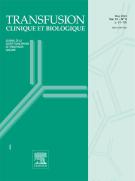The potential mechanisms of extracellular vesicles in transfusion-related adverse reactions: Recent advances - 11/04/25

Highlights |
• | Blood cell-derived EVs drive transfusion-related inflammation, coagulation, and immune modulation. |
• | Advanced proteomics improves EVs analysis, aiding blood transfusion safety and diagnostics. |
• | Optimized EVs isolation methods are crucial for resolving heterogeneity and improving accuracy. |
• | Comprehensive EVs characterization deepens insights into transfusion-associated complications. |
Abstract |
Blood transfusion is an irreplaceable clinical treatment. Blood components are differentiated and stored according to specific guidelines. Storage temperatures and times vary depending on the blood component, but they all release extracellular vesicles (EVs) during storage. Although blood transfusions can be life-saving, they can also cause many adverse transfusion reactions, among which the effects of EVs are of increasing interest to researchers. EVs are submicron particles that vary in size, composition, and surface biomarkers, are encapsulated by a lipid bilayer, and are not capable of self-replication. EVs released by blood cells are important contributors to pathophysiologic states through proinflammatory, coagulant, and immunosuppressive effects, which in turn promote or inhibit the associated disease phenotype. Therefore, this review explores the potential mechanisms of hematopoietic-derived EVs in transfusion-associated adverse reactions and discusses the potential of the latest proteomics tools to be applied to the analysis of EVs in the field of transfusion medicine with a view to reducing the risk of blood transfusion.
Le texte complet de cet article est disponible en PDF.Keywords : Extracellular vesicles (EVs), Transfusion-Related Adverse Reactions, Proteomics
Plan
Bienvenue sur EM-consulte, la référence des professionnels de santé.
L’accès au texte intégral de cet article nécessite un abonnement.
Déjà abonné à cette revue ?

